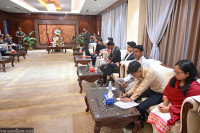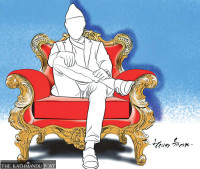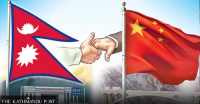Opinion
Meaningful interpretation
Nepal’s complex yet creative narratives assume avatars of different forms and convenience
Nepal like all old nations has engendered multiple narratives, some grand, others real but not fully narrated. The narratives that warrant greater attention—especially during a period in history when Nepal is ushering in a new era with the elections of the first republican constitution which are currently underway—dominate the principal political and cultural discourses of this country. Some of the narratives are more prominent than the others. Interestingly, some narratives of yore continue to shape the present interpretations, whether they are presented as fossilised tales or as stories of what is called shared pride. Opinions vary about them. That is both a matter of historical pattern and paternalism. Curiously, these |narratives are still functioning.
Constant narratives
An old interpretative narrative whose authorship is ascribed to king Prithvi Narayan Shah, who created the modern Nepal, goes like this—Nepal’s position for being geo-politically sandwiched between two giant powers in the north and the south is like that of a yam that is tucked between two huge boulders. This imagery is familiar to the farmers who still plant yams in the fields or by rocks. Curiously, king Shah’s slightly exaggerated farmer imagery still holds a place of importance in the Nepali narrative. Each event that warrants the attention of the big neighbours draws its interpretative strength from this narrative, and it is remembered more than ever today, especially when Nepali political parties feel that they can draw their political succour from either China or India according to their leanings. Theoretically this perpetual imbrication of the Nepali state’s position with India (it was the English East India Company with PN Shah) and China does not let the old king’s spectre rest. Instead, what I see today is that certain mysticism is created out of that spectral spherical boulder that is imbricated with layers of interpretations.
New narratives are added with each passing event. For example, the unification of the major Nepali communist parties has generated a number of interpretations. Some say China is behind this event; others say this is India’s style of working with Nepal’s political parties. A studious and intelligent former Nepali ambassador to China said to me, “…such interpretations are mere political fantasies”. Similarly, a former ambassador and scholar said, “Nepali political interpretations need the India-China boogies to work on”. I personally feel that Nepal’s historical narratives assume avatars of different forms and convenience, and the geo-political positioning of Nepal trigger them. There are too many different narratives to cover here.
Winds of change
But some current narratives have finance and power as their source. For example, the mysticism created by a market economy and the neo-liberal underpinnings of financial policies of the post-revolution governments have created many narratives that are directly linked to the political power order. That is triggered by an almost open practice of financial dealings involving power generating institutions, including, sadly, medical and other institutions that are directly related to people’s health and simple welfare services. A strange narrative that is repeated by the media and books, and is also covered in political discussions is related to the big projects of prestige that are not accomplished. The development works of national prestige do not spend the money earmarked for them. At the end of the year, the dismal reports of inaction and incompletion now deserve to be called the narratives of incompletion. The Melamchi Water Supply Development project has become a quaint story of vaguely raised hopes of thirsty people in a certain capital in a certain land, which was never completed for some reasons. And that is the style of folkloristic narrative. The entire city is ripped apart, and dust reigns supreme in that capital. And the denizens of that city walked freely, unmindful of the dusty breeze buffeting their visages. And so the narrative goes? Nobody knows the reason why the project does not get completed.
But as surprise would have it, the narrative of Shangri-La holds true. After the big earthquake of 2015 that shook Everest, swept away the entire Langtang valley, and demolished great architectural sites and places of great cultural importance, people from different parts of the world have started coming to Nepal in hordes, searching for Shangri-La. Reports say more Shangri-La seekers are coming in this year, creating opportunities for the state managers and political actors if they want to help such projects. But if they prefer not to act in such a situation, the people of Nepal, especially those whom I prefer to call the ‘great creative other’, will not cease their efforts to keep this narrative alive. The creative other includes everybody who can contribute to keep the Shangri-La alive. I too am making humble efforts to keep up the narrative by writing plays about the great Newar culture, Buddhist aesthetics and the common people’s labour. Similarly, the narratives of fairness, struggle, satyagraha, peaceful protests, international art festivals, theatres and poetry readings will continue to thrive. Writers have their own ways of seeing these narratives. For example, after the political change of 2006, Nepal saw events in a creatively unique way.
Nepali people saw great revolutionary and peace events. We academics—fine scholars, creative activists and writers—saw such events and participated in them. The events, however, crossed challenging modes. People were displaced, many got killed, but the period brought forth the first democratic republican constitution and now historical elections are being held. But in the early years of the decade, Nepali fiction writers became curiously interested in narratives of a political nature. Several of them fictionalised the events. They used the political personas known in politics today as their characters and protagonists in their novels. They wrote stories of this twilight consciousness. My interpretation of them as a literary critic is that the creative people, or the writers, like the great artists and participants of the creative other, were responding to the narratives of hope and a power of a different order. This piece is just a proposal to read the complex yet creative Nepali narratives in this period when we see creative cyclones rising in this land.




 18.12°C Kathmandu
18.12°C Kathmandu









